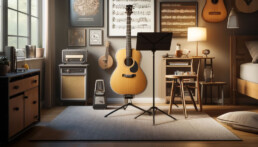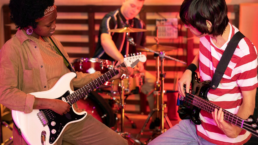Designing a Guitar Practice Regimen for All Skill Levels
The guitar is an incredibly versatile instrument that offers endless possibilities for musical expression. However, mastering it requires dedication, structured practice, and the right resources. Whether you’re picking up the guitar for the first time or you’re an experienced player looking to advance your skills, setting up a targeted practice regimen is crucial. Here’s how to structure your guitar practice sessions effectively across different skill levels, and how online platforms like JamPlay and TrueFire can enhance your musical journey.
For Beginners: Laying the Groundwork
1. Establish Routine Practice: Start with 20-30 minutes of practice a day. Consistency is more important than duration in the early stages to build muscle memory.
2. Focus on Basic Techniques: Learn the basic chords, strumming patterns, and essential scales. These fundamentals are the building blocks of all guitar playing.
3. Simple Songs and Exercises: Engage with easy songs that incorporate the chords and rhythms you’re learning. This will help build confidence and enjoyment early on.
4. Utilize Tools: A metronome and a tuner are essential tools. A metronome helps with rhythm and timing, while a tuner ensures your guitar is always sounding right.
For Intermediate Players: Enhancing Skills and Musicality
1. Increase Practice Time: Aim for 40-60 minutes per session. As you build endurance and skill, longer sessions will become more productive.
2. Explore Scales and Soloing: Dive into pentatonic and major/minor scales. Start improvising simple solos to develop your ear and enhance finger dexterity.
3. Expand Your Repertoire: Learn songs from different genres to understand various playing styles and techniques. This will also keep your practice sessions engaging and challenging.
4. Theory and Composition: Begin studying music theory. Understanding how music works will improve your playing and songwriting skills significantly.
For Advanced Players: Mastering the Instrument
1. Master Advanced Techniques: Focus on mastering techniques such as fingerstyle, advanced bending, tapping, and sweep picking. Each technique can open new doors in terms of what you can play.
2. Complex Compositions: Learn and perform complex pieces that challenge your technical and musical abilities. This might include classical guitar pieces, jazz standards, or intricate rock solos.
3. Personal Style and Improvisation: Develop your unique sound by experimenting with different musical styles and improvisation. This is also a good stage to start writing your own music.
4. Perform and Collaborate: Seek out opportunities to perform, whether live or online, and collaborate with other musicians to expand your skills and experience.
Leveraging Online Guitar Lessons with JamPlay and TrueFire
While personal practice is essential, accessing expert guidance can significantly accelerate your progress. This is where online platforms like JamPlay and TrueFire come in. Both platforms offer comprehensive lessons tailored to different skill levels and musical tastes.
JamPlay boasts a vast array of lessons focusing on different guitar techniques and genres, complete with live courses and bootcamps that provide real-time feedback. TrueFire, on the other hand, offers extensive video lessons and interactive learning tools designed by renowned guitarists. Both platforms can be particularly beneficial for intermediate and advanced players looking to refine their techniques and expand their musical vocabulary.
For beginners, these sites offer structured pathways that help demystify the early stages of learning guitar. Intermediate players can dive deeper into specific genres or techniques, and advanced players can tackle high-level concepts with specialized courses.
Incorporating online lessons from JamPlay and TrueFire into your practice regimen not only provides structured learning but also introduces a community aspect to your journey, keeping you motivated and engaged. With the right blend of personal practice and expert guidance, mastering the guitar becomes a more attainable and rewarding endeavor. Happy strumming!
Special Offer for Blog Readers
Begin your guitar journey or take your skills to the next level with JamPlay + TrueFire. We offer a free 14-day All Access trial for new students, giving you access to thousands of video lessons and expert guidance. Sign up today (no credit card required) and become a better player today!
The Top 10 Guitar Solos of All Time: A Journey Through Strings and Time
Guitar solos are the heart and soul of many rock and roll masterpieces. They have the power to elevate a song from great to legendary, leaving an indelible mark on listeners and shaping the course of music history. This blog explores the top 10 guitar solos of all time, each distinct in technique and emotion, showcasing the skill and creativity of their performers. Let’s dive into what makes these solos unforgettable.
1. "Stairway to Heaven" - Jimmy Page (Led Zeppelin)
Perhaps the most iconic guitar solo of all time, Jimmy Page’s work in "Stairway to Heaven" is a masterclass in building momentum. Starting with a gentle, melodic touch, it escalates into a powerful, high-energy climax, perfectly mirroring the song’s lyrical ascent to its spiritual zenith.
2. "Comfortably Numb" - David Gilmour (Pink Floyd)
David Gilmour’s second solo in "Comfortably Numb" is often cited for its profound emotional depth. Played with a soul-stirring blend of technical prowess and raw emotion, this solo beautifully complements the song’s theme of isolation and detachment.
3. "All Along the Watchtower" - Jimi Hendrix
While Bob Dylan wrote the song, Jimi Hendrix owned it with his electrifying guitar work. Hendrix’s solo is a wild, improvisational ride that incorporates his signature use of the wah-wah pedal, showcasing his revolutionary approach to electric guitar.
4. "Eruption" - Eddie Van Halen
Eddie Van Halen redefined what electric guitar could be with "Eruption." This solo is a technical marvel, featuring tapping, dive bombs, and lightning-fast scales that almost single-handedly popularized the shredding technique.
5. "Hotel California" - Don Felder and Joe Walsh (Eagles)
The dual guitar solos at the end of "Hotel California" are a perfect example of harmony and interplay between two guitarists. Felder and Walsh’s solos are meticulously crafted, delivering a hauntingly beautiful finish to the song’s narrative of decadence and illusion.
6. "Free Bird" - Allen Collins and Gary Rossington (Lynyrd Skynyrd)
"Free Bird’s" extended guitar outro is legendary in the rock community. The solo showcases an extraordinary interplay of rhythm and lead guitar, culminating in a thrilling, high-octane crescendo that has become a symbol of artistic freedom.
7. "November Rain" - Slash (Guns N' Roses)
Slash's solos in "November Rain" are as grandiose as the song itself. His use of a wide vibrato and melodic sensibility cuts through the orchestral backing, making it a poignant highlight of the song.
8. "Crossroads" - Eric Clapton (Cream)
Recorded live at Winterland Ballroom, Clapton’s fiery solos in "Crossroads" are a tribute to his blues roots and a demonstration of his exceptional improvisational skills. This solo is often praised for its aggressive articulation and dynamic pacing.
9. "Bohemian Rhapsody" - Brian May (Queen)
Brian May's solo in "Bohemian Rhapsody" seamlessly blends with the eclectic elements of the song. His precise, melodic playing contributes to the dramatic narrative of the track, making it a pivotal moment in this operatic rock anthem.
10. "Voodoo Child (Slight Return)" - Jimi Hendrix
Another Hendrix entry, "Voodoo Child (Slight Return)" features a blistering solo that encapsulates his skill and raw power. Using a wah-wah pedal to its full effect, Hendrix delivers a visceral, improvisational performance that feels like a force of nature.
What Makes These Solos Special?
Each of these guitar solos transcends mere technical skill, touching upon the ineffable qualities of emotion, storytelling, and cultural impact. They elevate the songs they are part of and stand as monuments in their own right, testifying to the extraordinary capabilities of the electric guitar.
These guitarists not only shaped the sound of their respective genres but also influenced countless others who picked up the guitar after them. From Jimmy Page’s mythical riffs to Eddie Van Halen’s blistering techniques, these solos continue to inspire both musicians and fans around the world.
Whether you’re a seasoned guitarist looking to learn these iconic solos or a music lover who appreciates the art of rock, these guitar masterpieces offer a glimpse into the soul of rock music itself.
Special Offer for Blog Readers
Begin your guitar journey or take your skills to the next level with JamPlay + TrueFire. We offer a free 14-day All Access trial for new students, giving you access to thousands of video lessons and expert guidance. Sign up today (no credit card required) and become a better player today!
Start Your Free JamPlay + TrueFire Trial Today >
Shredding the Metal Way: Master Metal Guitar
Metal music, with its powerful riffs and complex solos, offers a thrilling challenge for guitarists. This genre, characterized by its aggressive sound and high-energy impact, demands both technical skill and creative expression. For those looking to master metal guitar, online guitar courses like those offered by JamPlay and TrueFire are invaluable resources.
RELATED: Learn Metal Guitar with JamPlay + TrueFire All Access >
The Appeal of Metal Guitar: Metal guitar playing involves distinct techniques such as palm muting, fast picking, and intricate soloing over complex time signatures. The sound is often heavy, using down-tuned guitars and high-gain amplification to create its signature aggressive tone. This blog explores how you can harness these elements to enhance your playing style and musicality.
Learning with JamPlay and TrueFire: Both JamPlay and TrueFire excel in offering specialized courses that focus on metal guitar. These platforms feature lessons from some of the genre’s top guitarists, providing insights into the techniques that define metal music.
- JamPlay’s Metal Guitar Courses:
- Beginner Courses: Start with the basics of metal guitar, including fundamental chords and scales that are essential for any budding metal guitarist.
- Advanced Techniques: For more experienced players, JamPlay offers lessons on faster picking techniques, complex riffs, and how to incorporate electronic effects that are staple in metal music.
- Artist Series: Learn directly from the masters. JamPlay’s artist series includes courses taught by renowned metal guitarists, offering genre-specific tips and personal insights.
- TrueFire’s Structure:
- Core Learning System: TrueFire’s structured learning path ensures gradual progression from basic to advanced concepts. This is ideal for ensuring a thorough understanding of metal guitar.
- Style-Specific Courses: Delve deeper into sub-genres like thrash, death metal, and progressive metal to discover stylistic nuances and playing techniques.
- Interactive Tools: TrueFire’s use of video lessons and interactive tablatures makes learning complex solos and riffs more approachable.
Techniques to Master: The blog details essential metal techniques such as sweep picking, legato, and tapping, and explains how these can be developed through courses on JamPlay and TrueFire. Each technique section includes recommended lessons and instructors from both platforms to guide readers.
Conclusion: Mastering metal guitar requires dedication, and with JamPlay and TrueFire, guitarists have access to an extensive range of resources to support their journey. From comprehensive lessons on core techniques to insights into the creative process of legendary metal guitarists, these platforms offer everything needed to excel in the metal scene.
By the end of this blog, readers will not only understand the key aspects of metal guitar but will also be equipped with the knowledge on how to access and benefit from the best online guitar learning resources, aligning perfectly with their musical ambitions.
RELATED: Learn Metal Guitar with JamPlay + TrueFire All Access >
Creating the Ultimate At Home Guitar Practice Space
Creating a dedicated practice space in your home for playing the guitar can significantly improve your learning experience, focus, and overall progression. Whether you're a beginner starting your musical journey or a seasoned player looking to hone your skills, having a personalized area that's conducive to practice is invaluable. Here's a guide to setting up your own home guitar practice space that fosters creativity, productivity, and musical growth.
1. Choosing the Right Location
Your practice area should be a quiet corner of your home where interruptions are minimal. Consider spaces that are somewhat isolated from the main living areas to reduce distractions. If you live with others, ensure this space allows you to practice without disrupting their activities, which might mean soundproofing might become necessary.
2. Soundproofing and Acoustic Treatment
While not everyone can fully soundproof a room, there are simple measures you can take to minimize sound leakage and improve the room's acoustics. Heavy curtains, rugs, and foam panels can absorb sound, reducing the echo and volume that escapes the room. This not only benefits others in your home but also enhances the quality of the sound you hear as you play.
3. Comfortable and Functional Furnishing
Comfort is key to maintaining focus during practice sessions. A sturdy chair with good back support and the right height is essential. Avoid chairs with arms, as they can restrict your playing movement. A music stand for holding your sheet music or guitar tabs at eye level will also help maintain good posture. Additionally, have a dedicated stand or area for your guitar to keep it safely within reach.
4. Organizing Your Space
Keep your practice space clutter-free and organized. Have a small shelf or cabinet to store your music books, tuners, capos, picks, and other accessories. This not only keeps your practice area tidy but also ensures everything you need is within arm's reach, maximizing your practice efficiency.
5. Lighting
Proper lighting is crucial for reading music and reducing eye strain. Natural light is ideal, but if that's not possible, invest in a good-quality lamp that can be adjusted to illuminate your music and guitar without creating glare.
6. Setting Up a Practice Routine
With your practice space set up, establishing a consistent practice routine is the next step. Your practice space should inspire you to stick to your routine. Consider posting a practice schedule on the wall and setting goals for what you aim to achieve in your sessions.
7. Incorporating Technology
In today's digital age, incorporating technology into your practice can be a game-changer. A laptop or tablet can be used for online lessons, to access backing tracks, or to record your playing. Invest in a good pair of headphones for playing along with music or using guitar learning apps without disturbing others.
8. Personalization
Finally, make the space yours. Personal touches like posters, plants, or a specific color scheme can make the space inviting and stimulate your creativity. Your practice area should be a place you look forward to spending time in.
Conclusion
Setting up a home practice space for guitar requires thoughtful consideration of location, comfort, acoustics, and personalization. By creating a dedicated area tailored to your needs, you'll be more inclined to pick up your guitar and practice regularly. Remember, the goal is to create a space that not only allows you to practice efficiently but also inspires your musical journey.
Special Offer for Blog Readers
Begin your guitar journey or take your skills to the next level with JamPlay + TrueFire. We offer a free 14-day All Access trial for new students, giving you access to thousands of video lessons and expert guidance. Sign up today (no credit card required) and become a better player today!
Start Your Free JamPlay + TrueFire Trial Today >
Boost Your Knowledge on Guitar Strings
Guitar strings are the soul of the guitar—they shape the instrument's voice, playability, and overall character. Whether you're a beginner picking up your first guitar or a seasoned player experimenting with different tones, understanding the nuances of guitar strings can significantly enhance your playing experience. This blog delves into the world of guitar strings, exploring the different kinds designed for various types of guitars, including classical, acoustic, and electric guitars.
1. The Core of Sound: Materials and Gauges
Guitar strings are made from various materials, each offering unique tonal qualities and playing characteristics. The two primary components of guitar strings are the core and the winding.
- Nylon Strings: Primarily used on classical guitars, nylon strings produce a soft, warm tone ideal for classical, flamenco, and folk music. They are gentle on the fingers, making them a favorite among beginners.
- Steel Strings: These are used on acoustic guitars and are made of steel cores wound with metal materials such as bronze, phosphor bronze, or nickel. They produce a brighter, louder sound compared to nylon strings, suitable for a wide range of music styles from folk and country to rock and pop.
- Electric Guitar Strings: Typically made from nickel-plated steel, pure nickel, or stainless steel, electric guitar strings are designed to produce a clear, articulate sound that complements the guitar's electronic amplification system. The choice between these materials affects the string's brightness and sustain.
The gauge, or thickness, of the strings also plays a crucial role in sound and playability. Heavier gauges offer more volume and sustain but require more finger pressure to play, while lighter gauges are easier on the fingers and facilitate faster playing and bending notes but may produce less volume and sustain.
2. Types of Strings for Different Guitars
- Classical Guitars: These guitars are strung exclusively with nylon strings. The top three strings (E, B, G) are made of pure nylon, while the lower strings (D, A, E) are nylon cores wrapped with a fine metal wire. This combination provides the classical guitar with its distinctive warm and mellow tone.
- Acoustic Guitars: Acoustic guitars use steel strings to achieve a bright, loud sound. The most popular materials for acoustic guitar strings are phosphor bronze, known for its warm, smooth tone, and 80/20 bronze (brass), which produces a brighter, more ringing quality.
- Electric Guitars: Electric guitar strings are generally made from nickel-plated steel or pure nickel. Nickel-plated steel strings offer a bright, clear sound, while pure nickel strings deliver a warmer, more vintage tone. Stainless steel strings are also available, known for their bright tone and resistance to corrosion.
3. Specialty Strings
Aside from the standard nylon, steel, and electric guitar strings, there are specialty strings designed to cater to specific needs:
- Coated Strings: These are standard strings coated with a thin layer of polymer to prolong their life by protecting against corrosion and dirt build-up. While slightly more expensive, they can last significantly longer than uncoated strings.
- Flatwound Strings: Often used by jazz and blues guitarists, flatwound strings have a smooth, flat surface that reduces finger noise and offers a mellower tone compared to the brighter sound of roundwound strings.
- Silk and Steel Strings: These are a hybrid of steel and nylon, designed to produce a softer sound than traditional steel strings, making them ideal for fingerstyle players seeking a gentle tone on an acoustic guitar.
4. Finding Your Sound
Choosing the right guitar strings is a personal journey. The perfect set of strings for one guitarist might not suit another, as the choice depends on playing style, desired tone, and physical comfort. Experimenting with different types of strings is key to finding what works best for you.
Remember, strings wear out and lose their tone over time, so regular changes are essential to maintaining your guitar's sound quality. Whether you're strumming chords on an acoustic guitar or shredding solos on an electric, the right strings can make all the difference in your music.
Special Offer for Blog Readers
Begin your guitar journey or take your skills to the next level with TrueFire. We offer a free 14-day All Access trial for new students, giving you access to thousands of video lessons and expert guidance. Sign up today (no credit card required) and become a better player today!
Start Your Free TrueFire Trial Today >
Amplify Your Guitar Skills: Merging JamPlay and TrueFire for Ultimate Practice Progress
Crafting a solid guitar practice routine is a cornerstone of mastering the instrument for both novices and seasoned players alike. In our digital era, the fusion of online learning resources like JamPlay and TrueFire can exponentially boost your guitar journey. These platforms are lauded for their comprehensive lesson libraries and tailored learning paths. This blog explores crafting an effective guitar practice schedule that synergizes the strengths of both JamPlay and TrueFire, setting the stage for remarkable musical growth.
Setting Musical Objectives
Identifying your musical aspirations is the first step toward structured practice. Whether it's conquering the blues, rocking out, or mastering multiple genres, having clear goals shapes your practice approach and guides you in harnessing JamPlay and TrueFire's resources effectively.
Designing Your Guitar Practice Plan
An optimal practice schedule covers various guitar-playing facets. Here’s a strategy to divide your practice time, incorporating both JamPlay and TrueFire resources:
- Warm-Up (10% of total practice time): Start with stretching and fundamental exercises to prepare your fingers. Simple scales and arpeggios work well.
- Technique Building (30%): Enhance your skills with specific technique drills. Both JamPlay and TrueFire offer lessons targeting skills from basic strumming to intricate solos, enabling personalized progression.
- Repertoire Expansion (30%): Learning songs not only boosts your playing skills but also keeps practice engaging. Dive into the extensive song libraries on JamPlay and TrueFire to find tunes that match your style and progress level.
- Music Theory and Ear Training (20%): Solidify your music theory foundation and hone your ear to improve improvisation and composition skills. Utilize the theory lessons and ear training tools available on both platforms for a well-rounded understanding.
- Creativity and Exploration (10%): Allocate time for improvisation, composing, or exploring new styles. This creative outlet applies your technical skills in a musical context, fostering growth and innovation.
Emphasizing Consistency
Regular practice is more beneficial than sporadic, lengthy sessions. Strive for daily practice, tailoring the duration to fit your schedule and goals, ideally between 30 minutes to an hour.
Harnessing JamPlay and TrueFire
Combining JamPlay and TrueFire enriches your learning experience with their personalized paths, interactive content, and vibrant communities. Here’s how to make the most of both platforms:
- Tailored Learning Experiences: Both platforms recommend courses and lessons based on your goals and current skill level, streamlining your learning process.
- Interactive Content: With a plethora of video lessons and interactive tablature across both sites, you can learn at your own pace, ensuring thorough understanding and mastery.
- Community Engagement: Staying motivated alongside a community is invaluable. Engage with both JamPlay’s and TrueFire’s forums, live workshops, and community events to share insights, ask questions, and learn from a diverse group of musicians and instructors.
Conclusion
Integrating JamPlay and TrueFire into your guitar practice schedule offers a dynamic, comprehensive approach to mastering the guitar. By setting clear objectives, structuring your practice time, maintaining consistency, and leveraging the unique strengths of JamPlay and TrueFire, you're on a path to significant musical achievement. Remember, learning guitar is a journey—embrace each step, celebrate your progress, and let your practice be powered by passion and the support of two of the best online guitar learning communities.
Special Offer for Blog Readers
Begin your guitar journey or take your skills to the next level with TrueFire. We offer a free 14-day All Access trial for new students, giving you access to thousands of video lessons and expert guidance. Sign up today (no credit card required) and become a better player today!
Start Your Free TrueFire Trial Today >
The Top 5 Easy Guitar Songs for Beginners: Master Your Chords
Embarking on your musical journey with a guitar in hand is an exhilarating experience. For beginners, mastering your first few songs is not just about practice; it's about choosing the right tracks that make learning enjoyable and achievable. In this blog, we'll explore the top 5 easy guitar songs perfect for beginners. These selections not only provide a solid foundation in basic chords but also ensure you're playing music you love from the start. Moreover, we'll introduce how platforms like JamPlay and TrueFire can elevate your learning experience, guiding you from strumming your first chord to mastering your first song.
RELATED: Check out JamPlay & TrueFire and stream hundreds of Song Lessons - FREE 14 Day Trial >
1. "Wonderwall" by Oasis
Chords to Learn: Em7, G, Dsus4, A7sus4
Starting with a classic, "Wonderwall" is a favorite among beginners for its simple strumming pattern and the minimal movement between chords. This song offers a great introduction to playing with dynamics and emotion, making it a rewarding first piece to learn.
2. "Let It Be" by The Beatles
Chords to Learn: C, G, Am, F
"Let It Be" is another excellent choice for beginners, featuring a beautiful melody and chords that are foundational in many songs. Learning this song will not only teach you about chord progression but also about the history of rock and roll.
3. "Horse With No Name" by America
Chords to Learn: E minor, D6add9/F#
Famous for its two-chord structure, "Horse With No Name" is arguably the easiest song for beginners to pick up. It's a perfect example of how a simple rhythm and chord pattern can create an iconic sound.
4. "I'm Yours" by Jason Mraz
Chords to Learn: G, D, Em, C
With a cheerful vibe and an infectious melody, "I'm Yours" is a fantastic song for beginners wanting to learn more about chord transitions and strumming patterns. The chords are straightforward, making it an enjoyable learning experience.
5. "Knockin' on Heaven's Door" by Bob Dylan
Chords to Learn: G, D, Am
This timeless classic by Bob Dylan introduces beginners to the concept of adding emotion to your strumming. The chord progression is simple yet powerful, offering an excellent foundation for playing songs with a strong narrative.
Elevate Your Guitar Skills with JamPlay & TrueFire
Learning these easy guitar songs is just the beginning of your musical journey. To truly master the guitar, consider leveraging online platforms like JamPlay and TrueFire. These platforms offer comprehensive lessons tailored to beginners, intermediate, and advanced players alike.
By starting with these easy guitar songs and utilizing resources like JamPlay and TrueFire, you're setting yourself up for success. Whether you dream of playing for friends and family or aspire to perform on stage, the journey of a thousand songs begins with a single chord. So, grab your guitar, tune up, and start strumming your way through these beginner-friendly classics. Your musical adventure awaits!
RELATED: Check out JamPlay & TrueFire and stream hundreds of Song Lessons - FREE 14 Day Trial >
Unleash Your Inner Rockstar: A No-B.S. Guide to Choosing Your First Guitar
Embarking on your guitar-playing odyssey isn't just picking up a musical instrument; it's an initiation into a cult of creativity, rebellion, and pure, unadulterated cool. Picking your first axe isn't a step to take lightly—it's about crafting your identity, making a statement, and preparing to set the world on fire with your riffs. Let's dive into what you need to look for when selecting your first guitar, cutting through the noise and getting straight to the raw essentials.
Electric vs. Acoustic: The Eternal Showdown
Forget the conventional wisdom. This choice isn't just about music—it's about attitude.
Acoustic Guitars: They're raw, honest, and stripped back. If your vibe is more coffee shop introspection than mosh pit mayhem, an acoustic might be your weapon of choice. They're no-nonsense instruments that will toughen up your fingertips and purify your soul with every chord.
Electric Guitars: Here's where the adrenaline kicks in. If you dream of melting faces with epic solos or shaking the ground with bone-rattling power chords, welcome to the electric brotherhood. With an electric, you're not just playing notes; you're conjuring magic, powered by electricity and sheer will.
Money Talks: Budgeting for Rebellion
You can't rock out without a guitar, but you don't need to sell your soul for one either. The market's flooded with killer axes that won't break the bank. Remember, it's not the price tag that makes the legend—it's the person wielding the guitar. Save some cash for the gear that'll amplify your rebellion: picks, straps, and maybe a few lessons from the school of hard knocks.
Size Matters: Picking the Perfect Fit
Your guitar should be an extension of yourself—comfortable, badass, and impossible to ignore. Don't get bogged down by tradition or what "experts" say. Go for a guitar that screams your style, whether it's a sleek, lightweight electric that's ready to rip or a compact acoustic that's full of soul. Play it loud, play it proud.
Playability: Because Pain is Temporary, but Rock is Forever
A guitar that's a pain to play is a one-way ticket to Quitville. Look for low action (that's the gap between the strings and the fretboard) and a neck that fits your hands like a glove. It's all about bleeding less and playing more. Get a setup if you have to; your fingers will thank you.
Sound: The Voice of Your Rebellion
The tone is everything. It's the voice of your rebellion, the signature of your sound. Acoustic players, chase that warm, woody resonance that feels like sunlight through trees. Electric aficionados, hunt for the growl, the buzz, the clean or crunchy tones that will define your musical manifesto.
Brand and Reviews: The Street Cred Check
Some brands are icons for a reason—they've been in the trenches, on the stages, and in the studios, proving their worth. Dive into the forums, stalk the reviews, and separate the legends from the wannabes. This is about finding a guitar that matches your ambition, one that's been through the fire and come out ready to rock.
Professional Setup: Tune It Up!
A beastly guitar in amateur hands is a tragedy. Get your guitar professionally set up to unlock its full potential. It's like tuning your hot rod before a street race; everything's got to be perfect if you're going to take the win.
Conclusion
Choosing your first guitar isn't just a decision; it's a declaration of who you are and what you stand for. Whether it's a sleek electric that howls at the moon or a soulful acoustic that whispers secrets in the night, your guitar is your partner in crime, your muse, and your weapon of choice. So choose wisely, play passionately, and welcome to the brotherhood and sisterhood of guitarists. The stage is waiting.
Special Offer for Blog Readers
Begin your guitar journey or take your skills to the next level with TrueFire & JamPlay. We offer a free 14-day All Access trial for new students, giving you access to thousands of video lessons and expert guidance. Sign up today (no credit card required) and start mastering guitar solos!
Start Your Free TrueFire Trial Today >
Duo Dynamics: Guitarist's Guide to Accompanying Vocalists
In the intimate setting of a jazz guitar-vocalist duo, the guitarist holds a unique position—not merely as an accompanist but as a co-narrator in a musical story. This configuration, devoid of the rhythmic safety nets typically provided by a bassist or drummer, demands a nuanced approach to support the vocalists effectively.
This blog post delves into the artistry and technicality required to complement and elevate the vocal performance, ensuring a harmonious and compelling duo presentation.
RELATED: Learn the art of accompaniment for Jazz Vocalists with Martin Taylor and Alison Burns >
Understanding the Vocalist's Needs
The first step in effectively supporting vocalists is understanding their needs and preferences. Each singer brings unique qualities to the table: range, timbre, style, and emotional expression. Engage in open communication with your vocalist, discussing their comfort zones, key preferences, and interpretation of the material. This dialogue is not a one-time conversation but an ongoing process, evolving with each rehearsal and performance.
Creating a Musical Dialogue
In a duo setting, the relationship between the guitarist and the vocalist is akin to a conversation, with each party listening and responding to the other. This dynamic interplay requires the guitarist to be attuned to the vocalist's phrasing, dynamics, and emotional cues. Instead of merely playing through arranged chords, the guitarist should adapt their playing to the ebb and flow of the vocal line, sometimes leading, sometimes following, but always in sync.
Harmonic Support and Color
The harmonic foundation provided by the guitar is crucial in a duo setting. Beyond basic chord accompaniment, the guitarist should explore voicings that complement the vocalist's range and the song's mood. This might mean choosing open, airy voicings for a dreamy ballad or denser, darker colors for a bluesy number. Experiment with extensions and alterations to add color and tension, but be mindful not to overshadow the vocal melody. The goal is to enhance, not compete.
Rhythmic Foundation and Flexibility
Without a rhythm section, the guitarist must also provide the rhythmic foundation. This requires a solid sense of time and the ability to convey the groove of the piece through comping patterns and bass line accompaniment. However, rigidity can be the death of expression in jazz. Cultivate a flexible approach, knowing when to hold the tempo steady and when to allow for rubato or push-and-pull interplay with the vocalist. This rhythmic empathy allows the vocalist to explore and express without losing the underlying pulse.
Dynamics and Space
Dynamics play a pivotal role in supporting a vocalist. The guitarist must be sensitive to the singer's dynamic range, matching their volume in softer passages and providing a fuller sound when the vocalist projects more powerfully. Equally important is the use of space. Silence can be powerful, allowing the vocalist's message to resonate and breathe. Learn when to play and when to pause, creating a dynamic landscape that complements the vocal performance.
Soloing with Sensitivity
Solo sections offer the guitarist a moment in the spotlight, but even here, the vocalist's presence should be considered. Approach solos as an extension of the song's narrative, maintaining the established mood and motifs. Use this opportunity to explore thematic material and demonstrate technical prowess, but always aim to return seamlessly to the vocal entry, maintaining the cohesive thread of the performance.
Rehearsal and Preparation
Effective duo performance is built on a foundation of thorough rehearsal and preparation. Work closely with your vocalist to arrange the pieces, deciding on intros, endings, key changes, and any instrumental interludes. Use rehearsals to experiment with different approaches and refine your interplay. However, be prepared to adapt during live performances, as the energy of the moment may lead you both in unexpected directions.
Listening and Learning
One of the best ways to improve your skills as an accompanist is to listen to great jazz duos, absorbing how master guitarists support and interact with vocalists. Pay attention to the nuances of their accompaniment, their use of space, and how they contribute to the overall mood and storytelling. Additionally, seek feedback from your vocalist and other musicians, remaining open to constructive criticism and new ideas.
Technical Tips for Guitarists
- Master a variety of chord voicings: Be comfortable with different chord shapes and inversions to provide harmonic richness and variety.
- Develop a solid fingerstyle technique: This allows for greater control over dynamics and texture, enabling you to play bass lines, chords, and melodies simultaneously.
- Practice rhythm and timing: Work with a metronome and play along with recordings to develop a steady, swinging time feel.
- Expand your repertoire: Familiarize yourself with a wide range of jazz standards and songs from the Great American Songbook, as these are often the backbone of vocal jazz performances.
- Work on your listening skills: Active listening will improve your ability to accompany sensitively and responsively.
Supporting a vocalist in a jazz guitar-vocal duo is an art that balances technical proficiency with deep musical sensitivity. It requires an understanding of the vocalist's needs, a commitment to the shared musical vision, and a continuous dialogue—both verbal and musical. By focusing on harmonic richness, rhythmic stability, dynamic interplay, and thoughtful communication, you can create a supportive and inspiring environment that allows both the guitar and the voice to shine. Remember, the goal is to accompany and enhance and elevate the entire musical experience, creating a memorable and moving performance for your audience.
RELATED: Learn the art of accompaniment for Jazz Vocalists with Martin Taylor and Alison Burns >
Elevate Your Guitar Practice with Jam Tracks - Download Free Now!
Embarking on a journey to master the guitar is an exciting endeavor that requires dedication, passion, and a well-rounded approach to practice. One often overlooked but invaluable tool in a guitarist's arsenal is the use of jam tracks. These backing tracks provide a dynamic and immersive experience that goes beyond the confines of solo practice. Let's explore the importance of incorporating tracks into your guitar practice routine.
RELATED: Instantly Download 200 FREE Jam Tracks at TrueFire >
Thanks to TrueFire and JamPlay, here are 5 fantastic Jam Tracks for you to practice with and use however you'd like! Happy playing!
Free Track: Slow Cooked Blues - Key of D - 58bpm
Instantly Download This Track and More at TrueFire >
Free Track: Soul Sauce - Key of D - 92bpm
Instantly Download This Track and More at TrueFire >
Free Track: Ode to Freddie - Key of G - 126bpm
Instantly Download This Track and More at TrueFire >
Free Track: I'm Beggin' Ya, Please! - Key of D - 120bpm
Instantly Download This Track and More at TrueFire >
Free Track: Native Eight - Key of Gm - 118bpm
Instantly Download This Track and More at TrueFire >
Incorporating jam tracks into your guitar practice routine is a game-changer that can elevate your playing to new heights. Not only do they make practice sessions more enjoyable, but they also provide a holistic approach to musical development. So, grab your guitar, download these free jam tracks, and let the music guide you on your journey to becoming a more versatile and accomplished guitarist.










